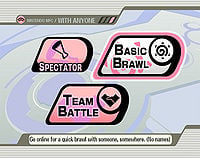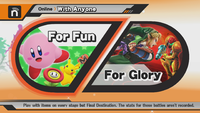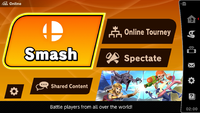Online play
Online play, sometimes known as netplay, is the act of playing games in the Super Smash Bros. series with other players via the Internet. Thus far, Super Smash Bros. Brawl, both versions of Super Smash Bros. 4, and Super Smash Bros. Ultimate have had netplay officially supported by Nintendo; while released without native netplay capabilities, modern methods exist for playing both Smash 64 and Melee online.
In Super Smash Bros.
- See also: Project64k
The Nintendo 64 does not natively support online play, though the idea was explored as part of the 64DD add-on. As such, online play for Smash 64 is accomplished through the use of emulators, such as Project64k. Owing to the lower system requirements of Nintendo 64 emulators and the rather fragmented community surrounding Smash 64, netplay is among the most common ways to play the game in the current scene. Initially, netplay was achieved via servers such as Smash FU and The Galaxy, but the community has since changed to mostly using peer-to-peer connections.
In Super Smash Bros. Melee
- See also: Slippi
While the Nintendo GameCube does have limited support for internet connectivity with appropriate adapters, Melee was released prior to the official release of these adapters, and as such, it does not natively support online play. Like Smash 64, online play for Melee is generally accomplished through emulators, particularly Slippi.
Prior to Slippi and Dolphin featuring netplay functionality, experimental online play was previously performed by a variety of tunneling softwares that could directly connect GameCube consoles to one another, such as via XLink Kai or exploits in Phantasy Star Online for the GameCube. These methods, however, were difficult to set up, required extensive knowledge of the software on hand and networking protocols, and required both players to be using the same version of Melee. Matches themselves often had desyncs, with items notably being implicated.
Online play later experienced mainstream popularity with the GameCube and Wii emulator Dolphin, which allowed for considerably easier connectivity between players, as well as being considerably more reliable in terms of synchronisation. Initially holding only niche popularity due to Dolphin's high system requirements, the gradually increasing power of personal computers and improvements to Dolphin's performance has allowed for more Melee players to partake in online play.
In Super Smash Bros. Brawl
- See also: Nintendo Wi-Fi Connection, Dolphin
The Nintendo Wii was the first Nintendo home console to support online play out of the box, with Nintendo allowing the device to take advantage of the Nintendo Wi-Fi Connection (WFC). As a result, Brawl was the first game in the series to officially support online play, allowing players to fight against either strangers or friends. In addition, gameplay mods for Brawl could also be unofficially played online via this protocol, though all players would need the mod in order to prevent desyncs from occurring.
Upon selecting the Nintendo Wi-Fi menu, the player is given two options: With Friends and With Anyone. With Friends requires inputing Nintendo Wii friend codes to connect with other players for private online games. With Anyone offers three options: Basic Brawl, Team Battle and Spectator Mode. Basic Brawl is meant for 1v1 matches where the rules were based on a mixture of a voting and lottery system. Team Battle is much of the same except for teams. Spectator Mode allows players to watch other online matches without participating. This mode included a betting system where spectators could win rewards for correctly predicting which fighter would win.
Official support for online play in Brawl was ended on May 20, 2014. A variety of methods, however, still allow for Brawl to be played online; replacement WFC servers, primarily Wiimmfi, make WFC mode continue to work just like it used to. The Dolphin emulator also runs Brawl and supports netplay with less latency than WFC.
In Super Smash Bros. 4
- Main article: Nintendo Network
Like Brawl, both Super Smash Bros. for Wii U and Super Smash Bros. for Nintendo 3DS natively support online play, though this time, the service is provided via the Nintendo Network. The service also offers a variety of benefits over Brawl's online play, particularly in regards to options and matchmaking. The overall concept, however, remains the same, with players being able to play against either strangers or friends via the internet. The latest version of the game must be downloaded to access online modes, as different players going online with different versions would cause compatibility issues and desyncing, if not break the game entirely.
As of version 1.1.0, upon entering the Online submenu, the player is given five options: With Anyone, With Friends, Tourney, Conquest, Spectate, and Share. Upon selectin With Anyone, there are two options to choose from: For Fun and For Glory. For Fun is an unranked mode that can be used with any ruleset. For Glory uses a matchmaking system based on Global Smash Power and is restricted to no items, and Ω Form stages only. With Friends functions similarly to Brawl. Tourney is similar to the mode in previous games, except online with occasional tourneys run by Nintendo themselves. This mode went defunct on November 8, 2017 after the discontinuation of Miiverse. Conquest aggregated global wins among specific groups of characters (known as teams) in With Anyone during a limited time, and determined the victor based on the number of wins. Players who backed the winning team would win prizes. The mode was discontinued on January 3, 2019. Share is a server that allowed players to upload content for others to view. Several options in this mode were discontinued November 8, 2017 after the discontinuation of Miiverse, including uploads to YouTube, sharing snapshots and sharing custom stages. However, sharing replay data and Mii Fighters is still available.
Citra and Cemu, emulators for the 3DS and Wii U respectively, have the ability to play online, though the process is not as refined as other projects like Slippi and requires some technical knowhow.
In Super Smash Bros. Ultimate
Ultimate has native online support much like Brawl and Smash 4. However, this time online play is a paid service as part of Nintendo Switch Online. Rather than selecting from modes with specific rules, players can now choose their own preferred rules and the game will attempt to match players with similar desires. Compared to previous games, Ultimate allows for a wider selection of rules when playing with anyone. Just like Smash 4, the latest version of the game must be downloaded to access the online modes for the same reasons.
As of version 4.0.0, upon opening the Online submenu, the player is given four options: Smash, Spectate, Shared Content, or Online Tourney. Upon choosing Smash, there are three options to choose from: Quickplay, Battle Arenas, and Background Matchmaking. Quickplay has the player select Solo or Co-op (local), with a Preferred Rules switch underneath the two options. Preferred rules include the format, time limit, stage, stock count, whether Final Smash Meter is on or off, and which items should be turned on. If a player accrues enough Global Smash Power with a single fighter, the player can use that fighter in Elite Smash: a mode similar to Quickplay where players are only matched with other players in Elite smash. However, the player needs to maintain that GSP count, and will be kicked from Elite smash if they dip below the threshold.
Upon choosing Solo or Co-op, the player(s) can choose their character(s), and are taken to the Online Practice Stage. There they can train with CPU partner(s) while waiting for opponent(s).
If the player(s) choose Background Matchmaking, they can choose Solo or Co-op, their fighters and preferred rules. While waiting for their opponent(s), they can participate in various different modes.
Battle Arenas are a new form of online play for the series, being able to make it visible for all (Public), or for Friends only. Arenas can have a password set, preventing unauthorized players from entering. The type can also be set, for All Skill Levels, Veteran Players, Glorious Smashers, Anything Goes, Playground, amiibo Battle (available after update 3.1.0), Elite Only, and Beginners Only (both available after update 6.0.0).
Many players have opted to use emulation via the yuzu emulator in combination with external video streaming software such as Parsec as a means to play Ultimate online. This has become popular in the wider competitive scene mainly due to the problems faced with the game's native online service, with some top players such as Fatality and Dark Wizzy using this technique to play.
In competitive play
Online battles being an outlet for serious competition has proven controversial since its introduction in Brawl. The inherent flaws of online play that offline play simply does not possess have always and will continue to be sticking points for the community. The inevitable latency caused by playing a game online makes the game being played less reaction-based, which has always been a hallmark of competitive Smash. This issue is exacerbated if at least one player has a poor internet connection, causing significant framerate drops, desyncs, and even complete disconnections. The issues of hackers is also a prevalent issue, as there is very little anyone can do to prevent someone from hacking the game, only disqualifying and banning them after the fact. These concerns have led the community to prefer offline play whenever possible and disregard most online competition as little more than diversions for the longest time.
However, this mentality has begun to shift in more recent years. The rise of the COVID-19 pandemic in 2020 forced nearly all public events to be heavily restricted in terms of attendance, move away from in-person and be held online, or shut down entirely. Smash tournaments were and to an extant still are no exception to this. Games like Smash 4 and Ultimate had a relatively smooth transition to online with native support and the necessary infrastructure. On the other hand, games like SSB and Melee that never supported online play were forced to resort to unofficial methods like emulation and third-party online services. Luckily, many services designed for these games to be played online have already existed for years. This has caused some trouble between the competitive scene and Nintendo, as several tournaments were forced to shut down after emulators and legally dubious copies of these games were being used. While the aforementioned problems with online still persist, the competitive scene has slowly begun to recognize that, give the proper equipment and preparation, online play is a valid method for competition with many high profile tournaments being online-only and annual circuits integrating online tournaments into their roster for credit towards the finals.
Players that frequently attend and perform consistently well in online tournaments have earned the title of Wi-Fi Warrior. The greater competitive community through this title acknowledges that these players do have skill at the game, but doubt their ability to perform as well in an offline environment do to rarely if ever playing that way. Whether this ideology is fair or not is still debated, but many stand by this assumption with evidence of otherwise top-level players struggling to get notable results offline.


